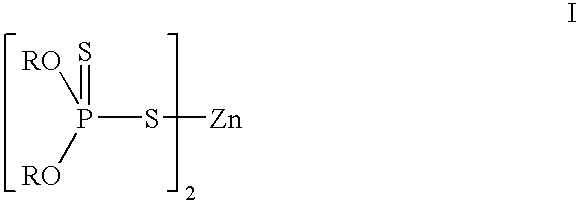Low phosphorus lubricating oil composition having lead corrosion control
- Summary
- Abstract
- Description
- Claims
- Application Information
AI Technical Summary
Benefits of technology
Problems solved by technology
Method used
Image
Examples
example 1
[0072]The low phosphorus lubricating oil composition of the present invention was prepared by blending a 0.78 wt % mixture of zinc bis(O,O′-di-(2-ethyl-1-hexyl) dithiophosphate (0.24 wt %, primary), zinc bis(O,O′-di-(2-butyl / 4-methyl-2-pentyl) dithiophosphate (0.15 wt %, secondary) and zinc bis(O,O′-di-(dodecylphenyl) dithiophosphate (0.39 wt %, aryl) with a Group II base oil of lubricating viscosity. The ratio of zinc bis(O,O′-di-(2-ethyl-1-hexyl) dithiophosphate to zinc bis(O,O′-di-(2-butyl / 4-methyl-2-pentyl) dithiophosphate was about 1:1, based on the phosphorus content. The ratio of the mixture of zinc bis(O,O′-di-(2-ethyl-1-hexyl) dithiophosphate and zinc bis(O,O′-di-(2-butyl / 4-methyl-2-pentyl)dithiophosphate to zinc bis(O,O′-di-(dodecylphenyl) dithiophosphate was about 2:1, based on the phosphorus content. The resulting ratio of the three-way mixture of zinc bis(O,O′-di-(2-ethyl-1-hexyl) dithiophosphate to zinc bis(O,O′-di-(2-butyl / 4-methyl-2phenyl) dithiophosphate to zinc bis...
PUM
 Login to View More
Login to View More Abstract
Description
Claims
Application Information
 Login to View More
Login to View More - R&D
- Intellectual Property
- Life Sciences
- Materials
- Tech Scout
- Unparalleled Data Quality
- Higher Quality Content
- 60% Fewer Hallucinations
Browse by: Latest US Patents, China's latest patents, Technical Efficacy Thesaurus, Application Domain, Technology Topic, Popular Technical Reports.
© 2025 PatSnap. All rights reserved.Legal|Privacy policy|Modern Slavery Act Transparency Statement|Sitemap|About US| Contact US: help@patsnap.com

